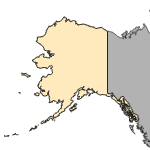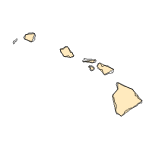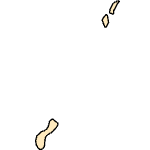Fundulus heteroclitus
(Mummichog)
Fishes
Native Transplant |
|
Common name: Mummichog
Taxonomy: available through
www.itis.gov
Identification: Smith (1985); Robins and Ray (1986); Menhinick (1991).
Size: 12.5 cm.
Native Range: Marine, brackish, and occasionally freshwaters from the Gulf of St. Lawrence to northeastern Florida (Robins and Ray 1986).



|

Alaska |

Hawaii |

Puerto Rico &
Virgin Islands |

Guam Saipan |
Hydrologic Unit Codes (HUCs) Explained
Interactive maps: Point Distribution Maps
Nonindigenous Occurrences:
Table 1. States with nonindigenous occurrences, the earliest and latest observations in each state, and the tally and names of HUCs with observations†. Names and dates are hyperlinked to their relevant specimen records. The list of references for all nonindigenous occurrences of Fundulus heteroclitus are found here.
Table last updated 12/17/2025
† Populations may not be currently present.
Means of Introduction: This species was introduced into ponds in New Hampshire, apparently via bait bucket release (Scarola 1973). It was transferred to far western Pennsylvania from the Delaware River drainage of the eastern part of the state (Raney 1938, cited in Trautman 1981), possibly as a baitfish. The other collections in Pennsylvania are believed to be bait bucket introductions (Denoncourt et al. 1975a, 1978).
Status: Previously established or locally established in New Hampshire and Pennsylvania (Scarola 1973; Trautman 1981). Denoncourt et al. (1975a) reported only two specimens from Sandy Run, and one specimen from the Juniata River. Established in the lower Susquehanna and Delaware drainages (Denoncourt et al., 1978).
Impact of Introduction: The impacts of this species are currently unknown, as no studies have been done to determine how it has affected ecosystems in the invaded range. The absence of data does not equate to lack of effects. It does, however, mean that research is required to evaluate effects before conclusions can be made.
References: (click for full references)
Denoncourt, R. F., T. B. Robbins, and R. Hesser. 1975a. Recent introductions and reintroductions to the Pennsylvania fish fauna of the Susquehanna River drainage above Conowingo Dam. Proceedings of the Pennsylvania Academy of Science 49:57-58.
Denoncourt, R.F., J.C. Fisher, and K.M. Rapp. 1978. A freshwater population of the Mummichog, Fundulus heteroclitus, from the Susquehanna River drainage in Pennsylvania. Estuaries and Coasts 1(4):269-272.
Raney, E. C. 1938. The distribution of the fishes of the Ohio drainage basin of western Pennsylvania. Doctoral dissertation. Cornell University, Ithaca, NY. 102 pp.
Robins, C. R., G. C. Ray, and J. Douglass. 1986. A field guide to Atlantic Coast fishes of North America. The Peterson Guide Series, volume 32. Houghton Mifflin Company, Boston, MA.
Scarola, J. F. 1973. Freshwater fishes of New Hampshire. New Hampshire Fish and Game Department, Division of Inland and Marine Fisheries. 131 pp.
Smith, C. L. 1985. The inland fishes of New York state. New York State Department of Environmental Conservation, Albany, NY. 522 pp.
Trautman, M. B. 1981. The fishes of Ohio. Ohio State University Press, Columbus, OH.
FishBase Summary
Author:
Fuller, P.
Revision Date: 8/14/2019
Peer Review Date: 1/28/2013
Citation Information:
Fuller, P., 2025, Fundulus heteroclitus (Linnaeus, 1766): U.S. Geological Survey, Nonindigenous Aquatic Species Database, Gainesville, FL, https://nas.er.usgs.gov/queries/FactSheet.aspx?speciesID=688, Revision Date: 8/14/2019, Peer Review Date: 1/28/2013, Access Date: 12/18/2025
This information is preliminary or provisional and is subject to revision. It is being provided to meet the need for timely best science. The information has not received final approval by the U.S. Geological Survey (USGS) and is provided on the condition that neither the USGS nor the U.S. Government shall be held liable for any damages resulting from the authorized or unauthorized use of the information.